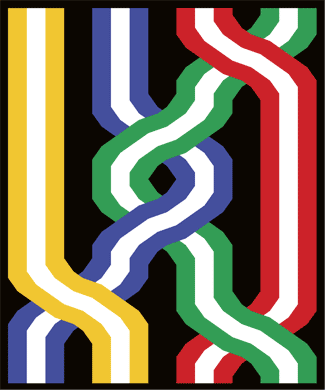Illustrations by Joseph Buzzell
This is a new column. It will serve as a place for us to discuss science and technology and weird philosophies and whatever else we want to force-feed your mind. We will do this by speaking with experts in various fields and relaying their knowledge to you. Our first hotshot is Alistair Savage, an associate professor of mathematics and statistics at the University of Ottawa who knows a thing or two about braid theory.
Topology is the branch of mathematics concerned with the spatial properties of objects that cannot be changed by twisting, deforming, or stretching. In order to overcome the myriad challenging concepts that result from studying these abstractions, mathematicians devise visual tools to help their brains wrap around otherwise completely intangible problems. One tool of particular interest to topologists and physicists is the braid form.
Imagine two vertical rows of three dots parallel to one another. First, connect the two middle dots together with a strand. Then connect the bottom-left dot to the top-right dot with a line that slopes steeply upward and crosses over the first strand. Next join the top-left dot to the bottom-right dot with a downward sloping line that crosses over the first two lines. Congratulations! You’ve just made a braid with three strands. A handy visual reference is below.
Simple enough. But to have your grey matter twisted into a double-loop bowline-level entanglement, look up “knot theory” and be thoroughly stumped. Knots and braids are of interest to physicists because of their applications to string theory. These type of applications, however, present an intriguing problem: If a mathematician can morph a knot, making it identical to another knot, twist by twist, without ever cutting the strings or passing one string through another, can said mathematician call the two knots identical? Must the two figures exhibit total disparateness in order for them to be considered as different? In other words, if everything is made of strings and we precisely re-create all the strings that make up you, are you still you?
Videos by VICE
Of course, this dilemma can be tricky to overcome using graphical representations alone. In order to represent these cases as algebraic representations, the knots must be reduced to braids and, in turn, the braids must be broken down into simpler pieces—single twists known as generators. One aspect of braid composition that new students find challenging is the twist order. The order of the twists doesn’t matter; the same braid will result if one twists the first and second strands or the ninth and tenth. It’s still considered the same braid no matter how many times the individual strands are rearranged.

There are also various braid categories. In the ribbon category, braids are thought of as flat, rigid ribbons that can twist around one another instead of strings that cross one another. Another, the symmetric monoidal category, contains braids that can be pulled apart without cutting strands, no matter the orientation of the crosses.
Today, many mathematicians are moving away from regarding braids as physical things—points connected by strands—and are instead using braids as metaphors. This is where braids become especially useful as tools for reaching new types of intuition. Instead of the aforementioned dots being actual, physical marks, think of them as some other type of mathematical object like a set or vector space. In this new paradigm, strands represent maps between sets and one can draw pictures of braids that are tied to abstract mathematical concepts. These braid renderings can then conversely be used to find these maps between sets or vector spaces. Fascinating, right?
At its essence, braid theory is a tool used to organize complex ideas in mathematics. As you’ve learned here, braids can simplify almost anything. With braids you too can develop intuition about maps between vector spaces, or maybe even tensor products!
More
From VICE
-

Screenshot: WWE -

Justin Paget/Getty Images -

Jonathan Raa/NurPhoto via Getty Images -

John Mulrooney (Credit: John Mulrooney/Facebook)
